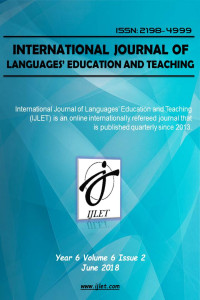An investigation into the Relationship between EFL Learners’ Foreign Music Listening Habits and Foreign Language Classroom Anxiety
Öz
Current study investigated whether there is a relationship between foreign music listening and classroom anxiety level with regard to foreign language learning. The effect of listening to music in the target language both as a habit in daily life and prior to the foreign language classes was the main concern of this study. The data were gathered from EFL learners at a health college of a state university in Turkey by implementing Foreign Language Classroom Anxiety Scale (FLCAS). The participants were chosen according to the purposeful voluntary bases. Statistical technique of Mann Whitney U Test was applied to the data by using software, and the results were reported. The study primarily found that the anxiety level in foreign language learning classes shows a significant difference in terms of listening to music in the target language prior to the foreign language classes. The results also showed that there is not a statistically significant difference between the participants related to foreign music listening habit in terms of their anxiety levels. Based on the results, it can be concluded that listening to music in the target language before EFL classes can be an effective way for overcoming the problems which stem from foreign language learning anxiety at health colleges.
Anahtar Kelimeler
Foreign language learning classroom anxiety listening to music foreign music
Kaynakça
- Aichhorn, N. & Puck, J. (2017). “I just don’t feel comfortable speaking English”: Foreign language anxiety as a catalyst for spoken-language barriers in MNCs, International Business Review, http://dx.doi.org/10.1016/j.ibusrev.2017.01.004.
- Aida, Y. (1994). Examination of Horwitz, Horwitz, and Cope's construct of foreign language anxiety: the case of students of Japanese. The Modern Language Journal, 78, 155-168.
- Anandari, C. L. (2015). Indonesian EFL students’ anxiety in speech production: possible causes and remedy. TEFLIN Journal, Volume 26, Number 1, DOI:http://dx.doi.org/10.15639/teflinjournal.v26i1/1-16.
- Basco, L. M. & Han, S-H. (2016). Self-esteem, motivation, and anxiety of Korean university students. Journal of Language Teaching and Research, Vol. 7, No. 6, pp. 1069-1078, DOI: http://dx.doi.org/10.17507/jltr.0706.02.
- Booth-Butterfield, S., Chory, R., & Beynon, W. (1997). Communication apprehension and health communication and behaviors. Communication Quarterly, 45, 235–250.
- Cakıcı, D. (2016). The correlation among EFL learners’ test anxiety, foreign language anxiety and language achievement. English Language Teaching; Vol. 9, No. 8; URL: http://dx.doi.org/10.5539/elt.v9n8p190.
- Čepon, S. (2016). The dissonance between teachers‘ and students‘ views on speaking anxiety in foreign languages for specific purposes. The New Educational Review, DOI: 10.15804/tner.2016.46.4.13.
An investigation into the Relationship between EFL Learners’ Foreign Music Listening Habits and Foreign Language Classroom Anxiety
Öz
Anahtar Kelimeler
Foreign language learning classroom anxiety listening to music foreign music
Kaynakça
- Aichhorn, N. & Puck, J. (2017). “I just don’t feel comfortable speaking English”: Foreign language anxiety as a catalyst for spoken-language barriers in MNCs, International Business Review, http://dx.doi.org/10.1016/j.ibusrev.2017.01.004.
- Aida, Y. (1994). Examination of Horwitz, Horwitz, and Cope's construct of foreign language anxiety: the case of students of Japanese. The Modern Language Journal, 78, 155-168.
- Anandari, C. L. (2015). Indonesian EFL students’ anxiety in speech production: possible causes and remedy. TEFLIN Journal, Volume 26, Number 1, DOI:http://dx.doi.org/10.15639/teflinjournal.v26i1/1-16.
- Basco, L. M. & Han, S-H. (2016). Self-esteem, motivation, and anxiety of Korean university students. Journal of Language Teaching and Research, Vol. 7, No. 6, pp. 1069-1078, DOI: http://dx.doi.org/10.17507/jltr.0706.02.
- Booth-Butterfield, S., Chory, R., & Beynon, W. (1997). Communication apprehension and health communication and behaviors. Communication Quarterly, 45, 235–250.
- Cakıcı, D. (2016). The correlation among EFL learners’ test anxiety, foreign language anxiety and language achievement. English Language Teaching; Vol. 9, No. 8; URL: http://dx.doi.org/10.5539/elt.v9n8p190.
- Čepon, S. (2016). The dissonance between teachers‘ and students‘ views on speaking anxiety in foreign languages for specific purposes. The New Educational Review, DOI: 10.15804/tner.2016.46.4.13.
Ayrıntılar
| Birincil Dil | İngilizce |
|---|---|
| Konular | İkinci Bir Dil Olarak İngilizce |
| Bölüm | Araştırma Makalesi |
| Yazarlar | |
| Yayımlanma Tarihi | 30 Haziran 2018 |
| Yayımlandığı Sayı | Yıl 2018 Cilt: 6 Sayı: 2 |


